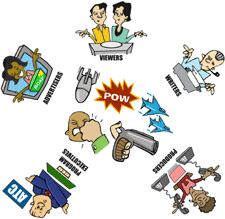Let’s Break the Circle of Blame! US Senate Testimony
|
|
Summary of Testimony by CML Founder Elizabeth Thoman to the United States Senate Commerce Committee: July 12, 1995
For 40 years, the American people have been engaged in a "circle of blame" about media violence: viewers blaming writers; writers blaming producers, producers blaming the networks, networks blaming the advertisers. And advertisers blaming the public for watching! It's time to stop the circle of blame and recognize we all share responsibility for the culture we are creating and passing on to our children.
The media industry must also accept responsibility for what they put into public space and time. Leaving this issue only up to parents is like asking parents to be responsible for the air their children breathe. That's impossible! Parents must be supported in their parenting task by the other sectors of society that also have everything to gain from the raising of healthy and well-adjusted kids.
For those same 40 years, the circle of blame has been fueled by one unanswerable question: "Does watching violence cause someone to become violent? The reason we've gotten nowhere on this issue for 40 years is because this is the wrong question to ask about violence in the media. To reduce the issue of media violence to "Does TV kill?", as the talk shows might put it, trivializes a complex question that faces our global society on the brink of the 21st century.
According to the American Psychological Association's 1993 report, Violence and Youth: Psychology's Response, there are not just one but four long term effects of viewing violence:
- Increased aggressiveness and anti-social behavior.
- Increased fear of being or becoming a victim.
- Increased desensitization to violence and victims of violence.
- Increased appetite for more and more violence in entertainment and real life.
The real question should be:
What is the long term impact on our national psyche when millions of children, in their formative years, grow up decade after decade bombarded with very powerful visual and verbal messages demonstrating violence as the preferred way to solve problems and normalizing fear and violence as 'the way things are?'
The Center for Media Literacy believes that to engage this question is to explore a fundamental issue of our time. But we need it to happen not just in political speeches or talk shows. We need to enroll millions of Americans in a locally-based "national conversation" to resolve the issue of media violence in their own lives and ultimately in our common society.
Perhaps violence has proliferated in our mass entertainment culture because citizens haven't had the information they need to make truly informed choices. In the past 20 years, we've learned to make different choices around smoking and cholesteral and buckling up your seatbelt. Media literacy proposes that, with different information, viewers might make different choices or engage in different behaviors.
I propose that media literacy education is a valuable and critical tool for learning to navigate our way through the sea of information and images that make up our modern media-saturated society. There is clear evidence that skills of media literacy can be taught to even young children and they can have an impact on a child's ability to apply critical thinking to a variety of media. Does that mean they will never watch Power Rangers again? Not necessarily. But I guarantee they'll never watch it passively or without thinking again — and that is a huge difference!
Our role at the Center for Media Literacy is to research and develop the educational tools to conduct this "national conversation" all over the U.S. This past year we have published, with assistance from the Carnegie Corporation and other foundations (and our own membership numbering over 2500 individuals and institutions), the first comprehensive educational program on the topic of television and media violence.
Beyond Blame: Challenging Violence in the Media is a participatory, sequenced collection of video-based discussion-oriented lesson plans designed to engage children and adults in rethinking how media violence affects them (and society). It also helps them practice skills to:
- reduce the amount of violent media watched;
- mitigate the impact of violent images that are seen;
- locate and appreciate the value of alternative entertainment that is not violent;
- express their informed opinion to policy makers, the media industry and to one another in public forums.
In short, it's a toolkit for education about core issues and an instruction book for responsible activism to create change.
I have no doubt that when millions of Americans have the opportunity to examine the many issues around media violence and practice skills of media advocacy and action (as laid out, for example, in the "Beyond Blame" program), we will see a dramatic increase in the public opinion and strategic actions that will slowly, but surely, yield changes in our media system.
Because it is an educational process and not a "quick fix" solution, media literacy may not make the headlines today. But it will influence the media world our children will inherit tomorrow. Ultimately this is what counts.
Speaking for the thousands of innovative teachers and group leaders who are exploring the exciting world of media literacy in schools and after school programs, churches and temples, libraries and community centers all over the U.S., I thank you for this opportunity to bring their transforming work to your attention.
Please feel free to duplicate and distribute these remarks. For additional information, contact:
Center for Media Literacy 3101 Ocean Park Boulevard, Ste. #200, Santa Monica, CA 90405
310-581-0260, www.medialit.net



